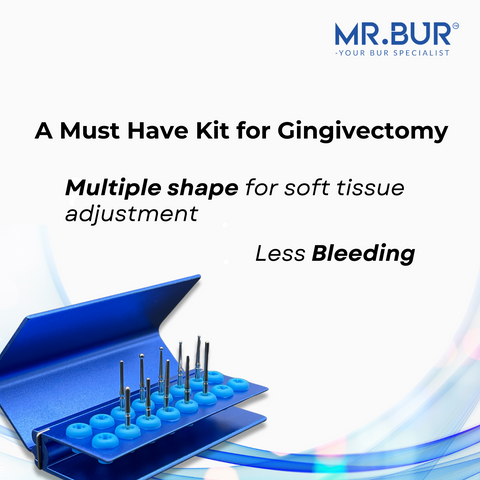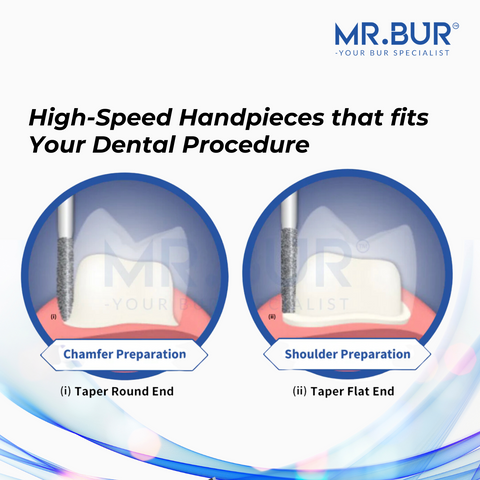Dental burs are essential tools for dentists, That are evolving significantly over time with advancements in technology. These Technological advancements have allowed dentists around the world to use a great variety of dental bur types available worldwide which have helped them perform thousands of successful dental procedures for the benefit of their dental patients. We will provide you with an overview of some common and practical types of dental burs used today to help you understand the tools that help dentists craft smiles.
What is the shank of a dental bur?
The shank is the long part of the dental bur that connects to the handpiece. Dental shanks come in various types and sizes to accommodate different handpiece speeds and mouth sizes. The main types of dental bur shanks are Friction Grip (FG), Handpiece (HP), and Right-Angle (RA).
Here is a brief explanation of the shank types available
Friction grip burs
Friction grip burs are also called FG burs, and they are designed for high-speed handpieces, making them the most popular choice.
The Friction grip burs come in two subcategories:
- FGSS (Friction Grip Short Shank) dental burs
- FGOS (Friction Grip Operative Surgical) dental burs
Latch type burs
known as RA burs, are made for low-speed contra-angle hand pieces.
Long straight shank burs also known as HP burs
HP shanks are commonly used in dental laboratories with low-speed hand pieces.
Dental Bur Shapes
The shape of a dental bur is crucial for its function. It refers to the head of the bur, which touches the teeth enamel or ceramics directly.
Dental burs come in many shapes, each suited to different patient needs and treatments.
Round Burs (Ball Burs)
Round Burs also known as ball bus are versatile tools used in various dental procedures. With their round heads, they're great for tissue excavation, tooth opening, cleaning, and selective grinding. They're also handy for bone surgery.
Pear Shaped Burs (330 Burs)
Pear shape burs, also known as 330 burs, are elongated with rounded heads. Primarily used for cavity preparation, they're also effective for removing caries and for trimming and finishing.
Spiral Cool-Cut Burs
Flat End Tapered Burs
Flat end tapered dental burs are designed for crown and bridge preparation, flat end tapered burs simplify and enhance the preparation process.
Round End Tapered Burs
Round end tapered dental burs are Popular for crown and bridge preparation, round end tapered burs are versatile tools with multiple dental applications.
Football Burs (Egg Bur)
Football burs, also known as egg-shaped burs, serve various purposes in dental procedures, including preparation, finishing, and trimming. They come in diamond, carbide, and gold variations for different uses.
Torpedo Burs
Torpedo burs, are given that name because of their torpedo-like shape, they are specifically designed for cavity preparation.
Inverted Cone Burs
Inverted cone burs are primarily used in dental surgery, inverted cone burs create undercuts for restorations or root canals. They're also effective for occlusal surface formation and caries removal.
Straight Fissure Burs
Straight fissure carbide burs feature parallel lines that aid in creating parallel lines and flat floors during cavity preparation. Cross cut fissure burs, a variation, are ideal for periphery contouring.
Tapered Fissure Burs
Tapered fissure carbide burs have tapered heads suitable for various actions during crown removal. They're optimal for sectioning multi-rooted teeth and reducing crown height.
Each of these dental bur shapes offer a specific benefit and are used in different helpful applications, which contributing to efficient and effective dental procedures.
Types of Materials Used To Make Dental Burs
Carbide Burs
Dental carbide burs are crafted from tungsten carbide, making them three times tougher than steel. They are ideal for tasks requiring strength and cutting efficiency, such as cavity preparation, cutting through metal and bone, and splitting teeth.
Ceramic Burs
Ceramic burs are excellent for dental surgery because they don't heat up easily due to ceramic's low heat conductivity. This makes them perfect for cutting bone during dental implant procedures.
Diamond Burs
Diamond burs are made with stainless steel covered in diamond powder of varying grit levels. The grit level decides how smooth or rough the tooth surface will be. Because diamond is the hardest natural material, these burs are very strong. They might leave rough finishes on teeth tissues, but finer grit diamond burs can smooth them out further.
Gold Burs
Gold burs are mainly used with high-speed turbines for smooth actions. They vibrate less, offering more precision during work, and their lower temperature helps maintain tooth vitality. They also provide delicate surface finishing.
Diamond Burs, Carbide Burs, Surgical & Lab Use Burs, Endodontic burs, IPR Kit, Crown Cutting Kit, Gingivectomy Kit, Root Planning Kit, Orthodontic Kit, Composite Polishers, High Speed Burs, Low Speed Burs
Subscribe our newsletter now!
















